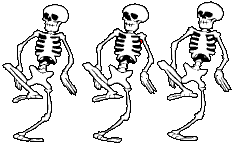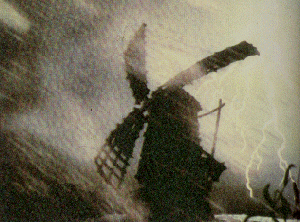Starting the Discussion
Silly Symphonies:
The Triumph of Technology
Maltin,
pp. 29-82
In
your notebook:
After the death of Walt Disney, the studio continued to produce animated features,
but Maltin's survey ends in the mid-1980s. For this journal, I'd like you to
go on from there and survey briefly what the Disney studio has done in animation
since 1985. The survey should flow into your own examination of some of the
ways in which the productions of the past 17 years or so can be connected with
the tradition established by Walt Disney and, conversely, some of the ways in
which they have moved into areas that might have surprised or even horrified
Walt. (This should be done by Thursday.)
Maltin's chapter
on Walt Disney is a fairly long one. Some of the basic information should reinforce
your reading in The Disney Version last week, but Schickel's interest
is primarily social and psychological, whereas Maltin's is primarily technical
and artistic, so you should be seeing the same development in a different context.
 In reading the chapter, you should pay particular attention to the way in which
Disney defined the medium of animation in the years between Steamboat Willie
(1928) and Snow White (1937) or Fantasia (1940).
In reading the chapter, you should pay particular attention to the way in which
Disney defined the medium of animation in the years between Steamboat Willie
(1928) and Snow White (1937) or Fantasia (1940).
- How inventive were Disney's
early cartoons, like Alice in the Jungle, which we watched in class?
What made the early Mickey cartoons different, according to Maltin? What was
the role of Ub Iwerks in this period?
- How many different stories
do we have of the origin of the character later known as Mickey Mouse? What
does this tell us about the men involved in his conception?
- Be ready to describe
the process through which Disney was able to synchronize the sound and image
in Steamboat Willie.
- What made the Skeleton
Dance (1929) a breakthrough animated short?
- How did the series known
as the Silly Symphonies differ from the character animation in the
Mickey cartoons?
- As his popularity grew,
what happened to Mickey Mouse as a character? How was this related the the
establishment of the Hays Office in Hollywood in the early 1930s?
- What's a storyboard and
why was it so useful to Disney animators? What other technological advances
originated at the studio during the 1930s?
- What did color add to
Disney animation? How was he able to keep a competitive edge in this area
through 1935?
- What was Disney's motivation
in paying for (and requiring) attendance at art classes for his animators?
- When did the studio introduce
Pluto, Goofy and Donald? Why was it so important to develop more character,
given the popularity of both Mickey Mouse and the Silly Symphonies?
- What is a model sheet
and what purpose does it serve?
- What were Mickey's most
memorable roles as a solo actor, according to Maltin? Is there a pattern here?
- The look that we now
think of as characteristically Disney in the late 1930s and from there on
is at least partly a result of the invention and use of the multiplane camera.
What was it and how did it work? What did it allow Disney's animators to do
that they had not been able to do before?
- We'll be coming back
to Snow White, but for now you should be ready to recap the process
through which Disney and his animators invented a new form, the feature-length
cartoon, which would outlive the cartoon shorts by decades in movie theaters.
- Everyone loved his first
few feature length cartoons, so why did Disney find such a different reception
for his Fantasia? What do you think caused him to misjudge nearly all
his audiences? What happened to short cartoon production at the Disney studio
in the 1940s, particularly the late '40s?
- Disney had prospered
during the Depression, but how was his studio affected by World War II? We'll
be returning to the wartime cartoons, but what practical realities did the
War bring into being for Disney Studios? What else was looming negatively
on the Disney horizon as the US moved toward war with the Germans and Japanese?
- How would you characterize
Walt Disney as a boss? Would you have considered working for him? Why or why
not?
- After World War II, Disney's
production of even feature cartoons began to be replaced by live action films.
Why?
- What was the appeal of
television for Disney in the 1950s? Why might he expect that audience to be
particularly receptive to his work?
- After Walt's death in
1966, the studio continued to produce both live action and animated features.
Maltin ends his survey in the mid-1980s; where has Disney gone since then?

Time permitting, we'll be
watching the following Silly Symphonies in class:
- Skeleton Dance
(1929)
- Flowers and Trees
(1932)
- The Three Little Pigs
(1933)
- The Flying Mouse
(1934)
- The Old Mill (1937)
Back
to Home Page
 In reading the chapter, you should pay particular attention to the way in which
Disney defined the medium of animation in the years between Steamboat Willie
(1928) and Snow White (1937) or Fantasia (1940).
In reading the chapter, you should pay particular attention to the way in which
Disney defined the medium of animation in the years between Steamboat Willie
(1928) and Snow White (1937) or Fantasia (1940). In reading the chapter, you should pay particular attention to the way in which
Disney defined the medium of animation in the years between Steamboat Willie
(1928) and Snow White (1937) or Fantasia (1940).
In reading the chapter, you should pay particular attention to the way in which
Disney defined the medium of animation in the years between Steamboat Willie
(1928) and Snow White (1937) or Fantasia (1940).